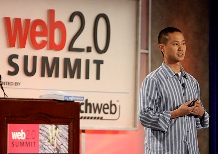Zappos CEO: transparency helped employees during layoffs


Is this bad? Not according to Tony Hsieh, Zappos.com CEO.
"We've generally found it to be beneficial to be public online about everything," he said. "And we will continue to do our best to be as transparent as possible."
Even, sometimes, if transparency is hard. Zappos.com gained prominence on the social media radar earlier this year when Hsieh, his executive team and hundreds of the company's employees created a one-brand army on Twitter. Those hundreds of employees reacted strongly to the news of the layoffs -- online -- on the company's Twitter-focused feed. To some companies, this might've created bit of a public relations nightmare or a crisis to manage. For Hsieh and his team, it was something to embrace.
"We believe that transparency is important and have continued to encourage our employees to Twitter," he said. "We also publicized on our blog the email sent to employees within minutes of it being sent internally."
If you watched the Zappos employee Twitter feed post-layoff, you would've seen a few things:
- Centralized reaction, which allowed the company insight on how to best handle sensitive situations with both laid off and current employees
- An outlet for each employee to react in a way that they know they would be heard -- by management, fellow employees, the media, and other listeners
- Public, thoughtful interaction between employees and management
- Laid off employees using the venue to plant seeds for future employment opportunities
- Communication with other laid of employees of other companies, and a new birth of networking
Zappos easily could've disbanded this (it's simply an aggregation of employee tweets) but it chose not to do so, in favor of its transparent culture, and the benefit of its employees. And, according to the company, there is nothing to hide. The transparency didn't stop there, either. Where some businesses might've counseled its CEO to stay out of reach during such a time, Hsieh continued his communications with customers and employees via Twitter, firsthand, and sometimes openly, addressing questions and concerns about the future of the company.
"Because of the large number of followers I have, I've always responded to questions through direct messages, as I don't want to Twitter out replies that might be irrelevant to most people," Hsieh said. "This isn't anything new; it's something I've always done."
From a business perspective, this was risky, but beneficial to Zappos.com. Could this transparency be beneficial to a larger or public company such as Sun Microsystems or Citigroup? Perhaps not. For a consumer-focused company like Zappos.com, however, it was a risk worth taking. Employees appreciated it, management benefited and even in the wake of a layoff, customers see Zappos.com as a company from which they want to buy.
Now, it's business as usual at Zappos.com and the company is as transparent as always. As Hsieh said in the latest note to employees last week:
Remember, this is not my company, and this is not our investors' company. This company is all of ours, and it's up to all of us where we go from here. The power lies in each and every one of us to move forward and come out as a team stronger than we've ever been in the history of the company.
Photo of Tony Hsieh by (CC) Brian Solis, www.briansolis.com, bub.blicio.us.